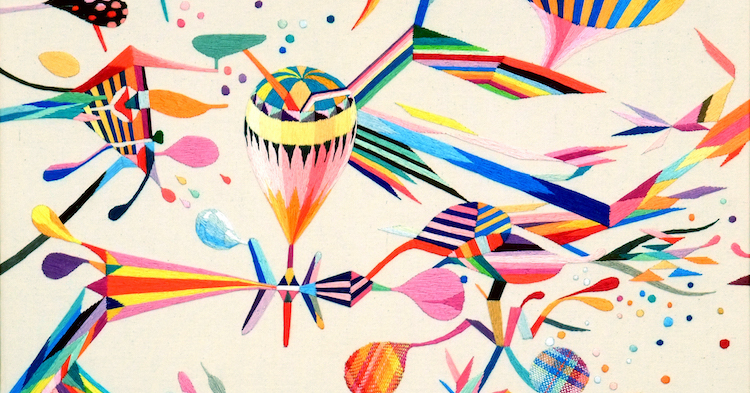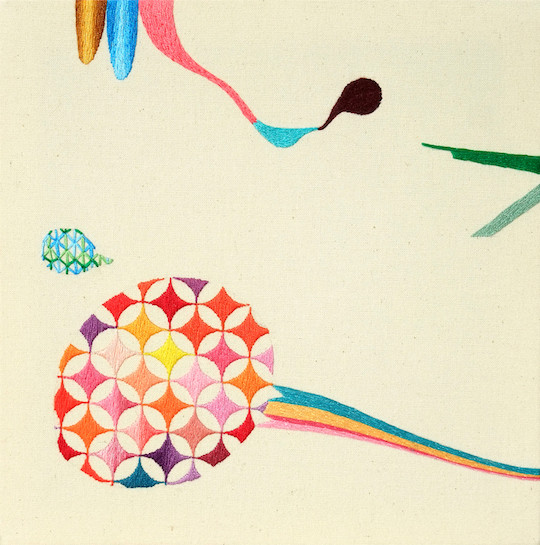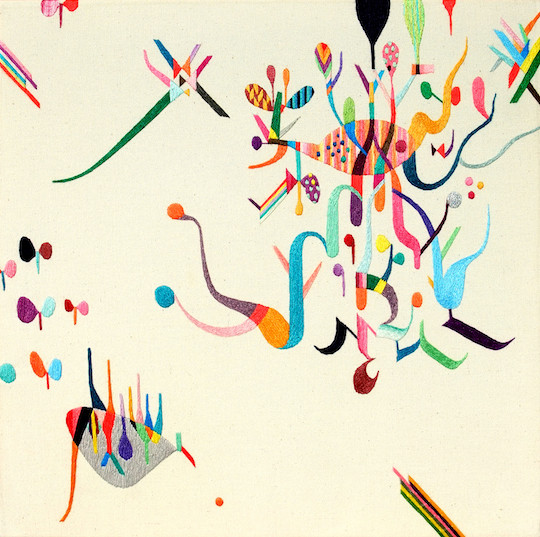Takashi Iwasaki: A visualization of an imaginary world

Encouraged by his creative, supportive and open-minded parents, at the age of twenty Takashi Iwasaki left his home country, Japan, to study Fine Arts in Canada.
As a student without a lot of income, embroidery seemed the right choice for him to investigate further, because the materials were affordable. But he soon embraced the medium, finding it extremely soothing and relaxing.
In this interview Takashi explains to us why he calls his work a visual diary of his imagination and why he likes to share this colourful and imaginative world with others.
Takashi Iwasaki: Nekoamedama, 2010, 43cm x 33cm, hand embroidery on twill
Embracing the painstakingly process of embroidery
TextileArtist.org: What initially attracted you to textiles as a medium?
Takashi Iwasaki: In 2005 I started embroidery as part of my drawing class assignment at university (I have Bachelor of Fine Arts from the University of Manitoba in Canada). One of the assignment’s topic was to work with something ‘decorative’.
As a student without a lot of income and resources, embroidery seemed to be very economical and feasible, though it cost a lot of time, which I had enough of back then. Embroidery had been used as a decorative craft medium for a long time, but I felt that it hadn’t been used very much as a fine art medium, so I thought it would be an interesting medium to explore.
Unlike paints and drawing materials that I used to use until then, to fill in just a small area of embroidery takes a lot of time, and the slowness of it was quite off-putting for me in the beginning. But as I got used to the process and finding certain characteristics that weren’t found in other mediums, I started enjoying it and even embracing the painstakingly laborious process as something more soothing and relaxing. I also like its ambiguous status of being between fine arts and crafts, depending on how it is executed and presented.
And, more specifically, how was your imagination captured by embroidery?
For the past ten years or so, my work has been either diary entries or depiction of my imaginary worlds and landscapes, or a combination of both.
There are enough interesting, captivating, or note-worthy things in my life, even in a seemingly very ordinary day, depending on how I look at things. I try to record those things like someone would write a diary. My work is a visual diary, and the only literal component in my work is the titles given to each piece. I say ‘diary’, but I don’t necessarily do it everyday. It’s more like a patchwork of my memories stretched in a moment, days, weeks, or sometimes years.
I like showing and sharing my imagination with others. There are a lot of things that I think about or create in my head, but those things are hard to be seen or felt by others, unless I make them into something more tangible than just a thought. Among the common five senses, the visual sense appeals to me the most, and I feel that it’s my forte and the strongest interest. Embroidery is one of my preferred methods to achieve that. It’s also very satisfying to see something that I have imagined before my own eyes. Things usually change or evolve between my thoughts and the final product, and in a way, it’s a way for me to organize my thoughts.
What or who were your early influences and how has your life/upbringing influenced your work?
My parents and being brought up in the countryside probably formed a large part of who I am now.
My dad is a handy man in my family and he likes to be crafty and make things with his hands. He didn’t let me use machine tools when I was little, but he taught me how to use a handsaw and other basic tools when I was in elementary school. Making things with origami and copying cartoon characters by looking at comic books were two of my favorite pastimes around that time.
A little obsessive with detail
In Japan, where I grew up until I was twenty years old, there’s a tradition of sending greeting postcards to families and friends for New Year’s Day. I guess it is equivalent to sending cards during the holiday season in Western countries. As a side note, an individual may receive hundreds of cards in one New Year’s Day season.
People nowadays send store-bought or ink-jet-printed cards for the occasion, but my dad used to make them with more traditional hand engraved wood-block printing, often with four or more plates. I picked up this habit and was making my own prints as a little kid. I liked making things with my hands and paying attention to detail ever since I was little, maybe I was a little too obsessive with details. Also my mom was good at oil painting when she was in high school.
I was a lucky kid, brought up by creative and open-minded parents who let me do most things that I wanted, as long as they weren’t unethical or too dangerous. Artistic activities were often encouraged at home, and when I said I wanted to go to an art school in Canada, they were all for it.
The location of my upbringing could be also a factor. The population of my hometown, Shimizu in Hokkaido, Japan, is only about 10,000 and is in the midst of farms and mountains. There wasn’t a wide range of ready-made entertainment out there, so I had to be creative to entertain myself.
It didn’t occur to me that I could be a self-employed artist
What was your route to becoming an artist?
At a fundamental level, I’ve always liked making things with my hands, so becoming an artist was just a very linear result of that – a pursuit of my strong passion. But artist as a career came to me with some surprises and constant learning of self-management and the business aspect of it by experience.
When I started studying art at university, I didn’t have a clear vision of what I’d be doing after graduation. When I was in Japan, I was vaguely thinking that I’d be a graphic designer or illustrator of some sort by being hired by a firm, because a lot of adults around me back then were employees of companies or organizations, and it didn’t occur to me that one could be self-employed in the arts field. The first step of self-navigation is following people around you, right? That’s what I did when I was a high school student in the countryside of Japan, where I didn’t know many art-related people.
Then in the third or fourth year at university, I started selling some of my drawings and paintings to people who liked what I was doing. First at low prices, and then gradually at higher prices. It was a cultural shock to me. In Japan ordinary people usually don’t buy artworks, or it probably doesn’t occur to them that art is something to be bought, but rather to be seen only at museums or in designed mass products; or they just see making art as a product of someone’s hobby, with no real monetary value. Now you understand why I was thinking about becoming a graphic designer or illustrator in the beginning.
In Japan works of internationally famous dead masters seem to gain most popularity in many museums, and people buy books, posters and postcards of those artworks; and that’s probably it. On the other hand, in Western countries people of a wide range of age and income are interested in actually buying artworks as long as they like what they see and can afford them.
This discovery pretty much determined me to stay in Canada and that is how my career as an artist began.
Tell us a bit about your chosen techniques.
Besides embroidery I make paintings, paper collages, and wooden sculptures among other things.
How do you use these techniques in conjunction with stitching?
I rarely use these other techniques together with embroidery. I like using them as separate mediums, at least for now. But all of them are important for my development. Something that I learn in painting and sculpture is transferred to embroidery, and vice versa. They feed each other and help me grow.
Bringing positive feelings to the viewer
How would you describe your work and where do you think it fits within the sphere of contemporary art?
My work looks very decorative, which most people will agree. One of my goals is to bring uplifting and positive feelings to the viewer, while allowing them to imagine and wonder what they are looking at, so it also functions as a psychological tool.
It’s hard to pinpoint where it fits within the sphere of contemporary art. Talking specifically about my embroidery, on a superficial level it can fall under craft, design and textile, but one may elaborate more on its function and context to categorize it as something else.
I like to keep some of it loose and unknown for myself because that suits my personality and also it isn’t my main concern in my making. As soon as I’m dead or after some decades or centuries, any of it will be ‘contemporary’ of the past. I just focus on my goals and make my work fit to my goals, instead of making it fit into an art term.
Do you use a sketchbook? If not, what preparatory work do you do?
I don’t have a sketchbook, but I sketch, draw, and write ideas on loose papers or on my smartphone. They’re like my check lists and usually get erased or discarded when they have been used in my final work or not needed anymore. I also take photos on my phone when it’s more appropriate than sketching or writing. I can easily imagine myself accumulating piles of sketches in a corner of a room just to collect dust, so going digital and getting rid of them is my way.
Family time as the most important source of inspiration
What environment do you like to work in?
I usually work in my home studio, because it’s the most readily available and convenient environment for me. But for embroidery, which is very light and portable, I sometimes go to cafes, libraries, and friends’ places to work on it. Stitching can be a very monotonous work, and I can easily multi-task by talking to someone or listening to something. Being in a different environment helps me feel fresh and can be a source of other ideas. I often listen to the radio or TV.
What currently inspires you?
Since having my daughter, who just turned one year old, she, my wife and I spend most of our time together. They and the time we spend together have been my favorite source of inspiration.

Takashi Iwasaki: Assemblage of six separately titled embroidery pieces, 2012, 61cm x 91.5cm, hand embroidery on canvas
How has your work developed since you began and how do you see it evolving in the future?
For both embroidery and painting, when I first started, I would begin working right on the surface without any sketches or underlining. And then for some time it changed to a fully-outlined process. Now it’s changing to a combination of both; some pre-outlined, some not. Stitches have become much cleaner, detailed, and complex, but I’m interested in possibly bringing back some of the more crude and simple stitches and design. The largest embroidery has been only about 50 x 50 cm, but I’m interested in making something much larger.
What advice would you give to an aspiring textile artist?
I’m just doing what makes me happy, and doing a lot of it. I don’t feel that I’m in a position to give advice to an aspiring textile artist, but that’s what I’ve been doing. That’s my way.
What other resources do you use? Blogs, websites, magazines etc.
Notably architectural and fashion magazines, furniture and interior design, TV programs, shapes of plants, but I like keeping all of my senses alert to find something interesting to me.
Where can readers see your work this year?
I’ve been featured in a book just launched in Australia in November.
‘The Craft Companion, The A-Z Guide to Modern Crafting’ by Ramona Barry & Beck Jobson, publisher Thames & Hudson.
I have a solo show until the end of November at
Gallery Lacosse
169 Lilac Street, Winnipeg, Canada
For more information please visit my website takashiiwasaki.info
Let your friends know about this artist’s work by sharing the article on social media. It’s easy, just click on the buttons below!























